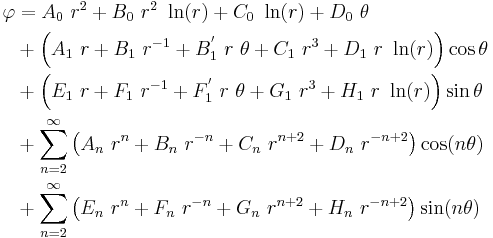Michell solution
The Michell solution is a general solution to the elasticity equations in polar coordinates ( ). The solution is such that the stress components are in the form of a Fourier series in
). The solution is such that the stress components are in the form of a Fourier series in  .
.
Michell[1] showed that the general solution can be expressed in terms of an Airy stress function of the form
The terms  and
and  define a trivial null state of stress and are ignored.
define a trivial null state of stress and are ignored.
Contents |
Stress components
The stress components can be obtained by substituting the Michell solution into the equations for stress in terms of the Airy stress function (in cylindrical coordinates). A table of stress components is shown below [from J. R. Barber (2002) [2]].
 |
 |
 |
 |
|---|---|---|---|
 |
 |
 |
 |
 |
 |
 |
 |
 |
 |
 |
 |
 |
 |
 |
 |
 |
 |
 |
 |
 |
 |
 |
 |
 |
 |
 |
 |
 |
 |
 |
 |
 |
 |
 |
 |
 |
 |
 |
 |
 |
 |
 |
 |
 |
 |
 |
 |
 |
 |
 |
 |
 |
 |
 |
 |
 |
 |
 |
 |
 |
 |
 |
 |
 |
 |
 |
 |
 |
 |
 |
 |
 |
 |
 |
 |
 |
 |
 |
 |
Displacement components
Displacements  can be obtained from the Michell solution by using the stress-strain and strain-displacement relations. A table of displacement components corresponding the terms in the Airy stress function for the Michell solution is given below. In this table
can be obtained from the Michell solution by using the stress-strain and strain-displacement relations. A table of displacement components corresponding the terms in the Airy stress function for the Michell solution is given below. In this table
where  is the Poisson's ratio, and
is the Poisson's ratio, and  is the shear modulus.
is the shear modulus.
 |
 |
 |
|---|---|---|
 |
 |
 |
 |
 |
 |
 |
 |
 |
 |
 |
 |
 |
 |
 |
 |
![\frac{1}{2}[(\kappa-1) \theta~\cos\theta %2B \{1 - (\kappa%2B1) \ln r\} ~\sin\theta]\,](/2012-wikipedia_en_all_nopic_01_2012/I/5cbd06386e31ed07ea364a834261d52b.png) |
![-\frac{1}{2}[(\kappa-1) \theta~\sin\theta %2B \{1 %2B (\kappa%2B1) \ln r\} ~\cos\theta]\,](/2012-wikipedia_en_all_nopic_01_2012/I/253bf550b5c1375f01276b68c1cbd6b3.png) |
 |
![\frac{1}{2}[(\kappa%2B1) \theta~\sin\theta - \{1 - (\kappa-1) \ln r\} ~\cos\theta] \,](/2012-wikipedia_en_all_nopic_01_2012/I/199bdee5f940a56eee8667bcff41f471.png) |
![\frac{1}{2}[(\kappa%2B1) \theta~\cos\theta - \{1 %2B (\kappa-1) \ln r\} ~\sin\theta] \,](/2012-wikipedia_en_all_nopic_01_2012/I/09d09d3ea76cb8c01336d89b42792169.png) |
 |
 |
 |
 |
 |
 |
 |
![\frac{1}{2}[(\kappa-1) \theta~\sin\theta - \{1 - (\kappa%2B1) \ln r\} ~\cos\theta]\,](/2012-wikipedia_en_all_nopic_01_2012/I/7754cf096d6d82bcf59608faa5e8a284.png) |
![\frac{1}{2}[(\kappa-1) \theta~\cos\theta - \{1 %2B (\kappa%2B1) \ln r\} ~\sin\theta]\,](/2012-wikipedia_en_all_nopic_01_2012/I/88d6c53e62bf62720ff2219c221bf453.png) |
 |
![-\frac{1}{2}[(\kappa%2B1) \theta~\cos\theta %2B \{1 - (\kappa-1) \ln r\} ~\sin\theta] \,](/2012-wikipedia_en_all_nopic_01_2012/I/e0490f3e2e18df3a24d0084374e8d318.png) |
![\frac{1}{2}[(\kappa%2B1) \theta~\sin\theta %2B \{1 %2B (\kappa-1) \ln r\} ~\cos\theta] \,](/2012-wikipedia_en_all_nopic_01_2012/I/ed2741a1f915868ea0a7b622956b6755.png) |
 |
 |
 |
 |
 |
 |
 |
 |
 |
 |
 |
 |
 |
 |
 |
 |
 |
 |
 |
 |
 |
 |
 |
 |
 |
 |
 |
Note that you can superpose a rigid body displacement on the Michell solution of the form
to obtain an admissible displacement field.
References
- ^ Michell, J. H. (1899-04-01). "On the direct determination of stress in an elastic solid, with application to the theory of plates". Proc. London Math. Soc. 31 (1): 100–124. doi:10.1112/plms/s1-31.1.100. http://plms.oxfordjournals.org/cgi/reprint/s1-31/1/100.pdf. Retrieved 2008-06-25.
- ^ J. R. Barber, 2002, Elasticity: 2nd Edition, Kluwer Academic Publishers.


